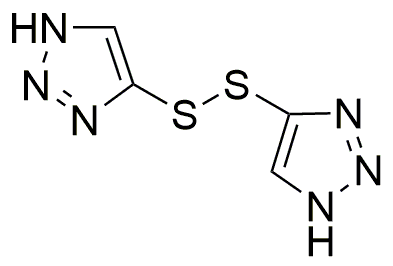4,4'-Di(1,2,3-triazolyl) disulfide is widely utilized in research focused on:
- Antimicrobial Agents: This compound is effective in developing new antimicrobial agents, offering a potential solution to antibiotic resistance in healthcare.
- Polymer Chemistry: It serves as a cross-linking agent in polymer synthesis, enhancing the mechanical properties of materials used in coatings and adhesives.
- Analytical Chemistry: The compound is used in the development of sensors for detecting heavy metals and other pollutants, contributing to environmental monitoring efforts.
- Pharmaceutical Development: It plays a role in drug formulation, particularly in creating targeted delivery systems that improve the efficacy of therapeutic agents.
- Bioconjugation: This chemical is valuable in bioconjugation processes, facilitating the attachment of biomolecules to surfaces, which is crucial in diagnostics and biosensors.
Informations générales
Propriétés
Sécurité et réglementation
Applications
4,4'-Di(1,2,3-triazolyl) disulfide is widely utilized in research focused on:
- Antimicrobial Agents: This compound is effective in developing new antimicrobial agents, offering a potential solution to antibiotic resistance in healthcare.
- Polymer Chemistry: It serves as a cross-linking agent in polymer synthesis, enhancing the mechanical properties of materials used in coatings and adhesives.
- Analytical Chemistry: The compound is used in the development of sensors for detecting heavy metals and other pollutants, contributing to environmental monitoring efforts.
- Pharmaceutical Development: It plays a role in drug formulation, particularly in creating targeted delivery systems that improve the efficacy of therapeutic agents.
- Bioconjugation: This chemical is valuable in bioconjugation processes, facilitating the attachment of biomolecules to surfaces, which is crucial in diagnostics and biosensors.
Documents
Fiches de données de sécurité (FDS)
La FDS fournit des informations de sécurité complètes sur la manipulation, le stockage et l’élimination du produit.
Spécifications du produit (PS)
Le PS fournit une description complète des propriétés du produit, notamment sa composition chimique, son état physique, sa pureté et les exigences de stockage. Il détaille également les plages de qualité acceptables et les applications prévues du produit.
Certificats d'analyse (COA)
Recherchez des certificats d'analyse (COA) en saisissant le numéro de lot du produit. Les numéros de lot et de lot se trouvent sur l'étiquette d'un produit, après les mots « Lot » ou « Lot de fabrication ».
Numéro de catalogue
Numéro de lot/série
Certificats d'origine (COO)
Ce certificat d'exploitation confirme le pays dans lequel le produit a été fabriqué, et détaille également les matériaux et composants utilisés et s'il est issu de sources naturelles, synthétiques ou autres sources spécifiques. Ce certificat peut être requis pour les douanes, le commerce et la conformité réglementaire.
Numéro de catalogue
Numéro de lot/série
Fiches de données de sécurité (FDS)
La FDS fournit des informations de sécurité complètes sur la manipulation, le stockage et l’élimination du produit.
DownloadSpécifications du produit (PS)
Le PS fournit une description complète des propriétés du produit, notamment sa composition chimique, son état physique, sa pureté et les exigences de stockage. Il détaille également les plages de qualité acceptables et les applications prévues du produit.
DownloadCertificats d'analyse (COA)
Recherchez des certificats d'analyse (COA) en saisissant le numéro de lot du produit. Les numéros de lot et de lot se trouvent sur l'étiquette d'un produit, après les mots « Lot » ou « Lot de fabrication ».
Numéro de catalogue
Numéro de lot/série
Certificats d'origine (COO)
Ce certificat d'exploitation confirme le pays dans lequel le produit a été fabriqué, et détaille également les matériaux et composants utilisés et s'il est issu de sources naturelles, synthétiques ou autres sources spécifiques. Ce certificat peut être requis pour les douanes, le commerce et la conformité réglementaire.


